Abstract
By applying the Wavelet Relevance Vector Machine (WRVM) method, this research proposes the loose zone of roadway surrounding rock prediction. Based on the theory of relevance vector machine (RVM), the wavelet function is introduced to replace the original Gauss function as the model kernel function to form the WRVM. Five factors affecting the loose zone of roadway surrounding rock are selected as the model input, and the prediction model of the loose zone of roadway surrounding rock based on WRVM is established. By using cross-validation method, the kernel parameters of three kinds of wavelet relevance vector machines (RVMs) are calculated. By comparing and analyzing the root mean square (RMS) error of the test results of each predictive model, the advantages and accuracy of the model are verified. In practical engineering applications, the average relative prediction errors of the Mexican relevance vector machine, the Morlet relevance vector machine and the difference of Gaussian (DOG) relevance vector machine models are accordingly 4.581%, 4.586% and 4.575%. The square correlation coefficient of the predicted samples is 0.95 > 0.9, which further verifies the accuracy and reliability of the proposed method.
1. Introduction
A surrounding rock loose zone refers to the stress redistribution of surrounding rock after excavation and the stress variation in surrounding rock, which leads to stress concentration. When the stress value exceeds the strength limit or yield limit, the roadway surrounding rock mass breaks up and forms a certain range of rupture area [1]. For many years, rock bolts are commonly used to enhance the stability of surrounding rock [2,3,4,5]. However, rock bolts are subjected to the loose zone of pre-load [6,7,8] or corrosion [9,10,11] and may fail [12]. The thickness determination of loose zone is not only a significant factor for the roadway surrounding rock’s stability, but also an important basis for the design of roadway support. Therefore, the accurate determination for the thickness of loose zone of roadway surrounding rock makes a great difference to improve the stability of underground engineering rock mass [13,14,15,16].
With the development of structural health monitoring [17,18,19], the methods to determine the loose zone thickness of roadway surrounding rock generally include acoustic wave test, numerical simulation and, support vector machine prediction [20,21]. The acoustic wave test method [22] can directly and accurately determine the range of loose zone, however the field operation is cumbersome and the cost is high. The numerical simulation method [23] is low cost and easy to realize. Nevertheless, it is obviously affected by the parameters of surrounding rock, and the result sometime has a large margin of error. Due to the nonlinearity of loose zone for surrounding rock and uncertainty of state and parameter measurement, the prediction of surrounding rock loose zone can be regarded as a typical complex and fuzziness problem. In recent decades, various intelligent methods, such as artificial neural network (ANN) [24,25,26], fuzzy logic [27,28,29], genetic algorithm (GA) [30,31], wavelet packet analysis (WPA) [32,33,34], supporting vector machine (SVM) [35,36,37], among others [38,39,40], have been developed to deal with nonlinearities and uncertainties. The support vector machine prediction method [41] can solve the problems of nonlinearity and small samples, and has achieved some success in the prediction of roadway surrounding rock loose zone. Nevertheless, the prediction accuracy and generalization ability of the model are affected by parameters.
Relevant vector machine (RVM) [42,43,44,45,46] is a sparse probability model alike support vector machine (SVM) proposed by Tipping in 2001. Its training process is based on Bayesian framework [47,48]. RVM can be used for regression estimation and prediction to obtain the distribution of predicted values. It not only has excellent nonlinear fitting and generalization ability, but also makes up for the defect that SVM needs to estimate regularization parameters and cannot get the prediction results based on probability [49,50]. RVM combines the advantages of core-based method and Bayesian theory, and establishes the relationship between a group of input vectors and its required output. Therefore, the selection of kernel functions plays an important role in RVM achieving good performance.
In practical applications, the commonly used kernels are Gauss kernels and polynomial kernels [51], however they cannot generate a complete set of bases in a space (such as square integrable space) by translation. The incomplete base will result in RVM not approaching any objective function in the kernel space. Wavelet is a function approximation tool in square integrable space [52,53]. Wavelet kernel function has been applied to SVM function approximation, which effectively improves the accuracy of the model [51]. Wavelet technology has great potential in dealing with approximation and classification of non-stationary signals [54,55]. Wavelet function is a group of bases [56], which can approximate any function. Therefore, this paper has combined wavelet technology with RVM, namely wavelet relevant vector machine (WRVM), and applied it to prediction of surrounding rock loosening zone of roadway. The feasibility and effectiveness of this method can be verified by practical engineering cases.
The paper is structured as follows: Section 2 shows the conception of the RVM and WRVM and the reasoning process of WRVM. Section 3 presents the key steps of the prediction model of surrounding rock loose zone using wavelet relevance vector machine. Section 4 compares the accuracy of the prediction models of SVM, RVM and WRVM, and predicts the loose zone of surrounding rock of 15 roadways by using the prediction model of WRVM. Section 5 concludes the paper.
2. Wavelet Relevance Vector Machine
RVM can be used for regression estimation and prediction to obtain the distribution of predicted values. It not only has excellent nonlinear fitting and generalization ability, but also makes up for the defect that SVM needs to estimate regularization parameters and cannot get the prediction results based on probability.
2.1. Relevant Vector Machine
The training sampling test is given by . The RVM model output is defined as [57],
In the formula, is the number of sample, the weight of the model, the kernel function, the sample matching non-zero ωi is called the relevance vector. The Figure 1 illustrates the RVM architecture model.

Figure 1.
The architecture of a relevant vector machine (RVM).
RVM inherits SVM modeling using structural risk minimization which has good generalization capability. However, SVM cannot give the confidence range. In order to make up for the defect that SVM cannot get the prediction results based on probability, RVM needs to learn the model in the Bayesian framework.
Assuming that the training samples are independent and contain Gauss noise with variance , the training sample’ likelihood function is expressed in the following [58,59,60]:
where
- .
According to the structural risk minimization, if the weights are not constrained, the direct maximization Equation (2) will cause serious over-fitting. To enhance the model’s generalization capability, the definition of the distribution of Gaussian prior probability for each weight value is made by RVM [60,61],
where is a parameter determining the prior distribution of weights .
According to the prior probability and likelihood distribution, the distribution of posterior probability by calculating the weights using Bayesian criterion is as follows [48,59],
where the mean value , the covariance , , when .
Therefore, the weights estimation is decided by the mean of the weight’s posterior distribution, and the uncertainty of optimal weight value can be applied to express the uncertainty of model prediction. To evaluate the model weights, the optimal value of the super-parameter must be estimated first. Based on the Bayesian framework, the likelihood distribution of hyper parameters is calculated as follows,
where the covariance .
The marginal likelihood derivative of log is set to 0, the updating formula is shown in the following:
where , refers to the diagonal element of a matrix . The achievement of sparsity is made because most parameters are evaluated as quite large values, so the basic functions are accordingly pruned by enforcing their weights to 0. During the progression of optimization, the vectors associated with the residual non-zero weights from the training set are called relevance vectors (RV) [48].
In addition, the marginal likelihood derivative of log is set to zero, the update formula is given:
By maximizing the hyper parametric likelihood distribution, its optimal value , can be found. For the new observed data prediction is applied to calculate the predictive distribution:
where, is the model predictive value, the predictive model’s variance information, and the predictive interval can be given by .
2.2. Wavelet Kernel Function
RVM transforms the input space into a high-dimensional space through the pre-selected kernel function while realizing data linearization in this space. In square integrable space, besides the inner product kernel form , there are translation invariant kernels for kernels .
Assuming that is a wavelet generating function, the translation invariant form of the wavelet kernel function can be constructed as [51,54]:
In the formula, d is the input vector dimension, and a refers to the scaling factor of the wavelet kernel function which is a constant that needs to be optimized. In the following section, several commonly used wavelet generating functions and their kernels are given.
(1) The Mexican hat wavelet generating function is , and the corresponding Mexican hat wavelet kernel function is given:
(2) The Morlet wavelet generating function is , and the corresponding Morlet wavelet kernel function is:
(3) The DOG wavelet generating function is , and the matching DOG wavelet kernel function is:
2.3. Wavelet Relevance Vector Machine
The architecture model of WRVM is similar to that of standard RVM. As illustrated in Figure 1, their major difference lies in the nonlinear mapping method and kernel function. A brief overview of the reasoning process of WRVM is given, as shown in Figure 2.
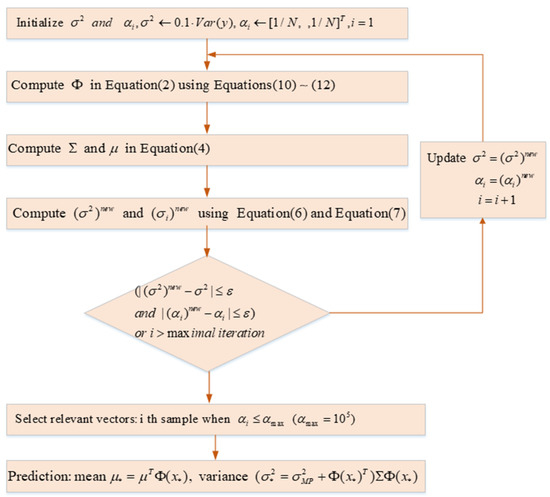
Figure 2.
Wavelet relevance vector (WRV) machine algorithm procedure.
2.4. Fitting Quality Estimation
To compare the model’s generalization capability, three measurements are introduced to test the capability of model fitting data and prediction [62], specifically as follows:
(1) Root mean square error (RMSE)
(2) Relative prediction error (RPE)
(3) Square correlation coefficient
where SSR is the residual squares’ sum, and SSY is the response variable squares’ sum.
3. Establishment of Predictive Model for Loose Zone of Surrounding Rock in Roadway
According to the theory of WRVM, a predictive model of loose zone of surrounding rock in roadway using WRVM has been established. As shown in Figure 3, the concrete steps are:
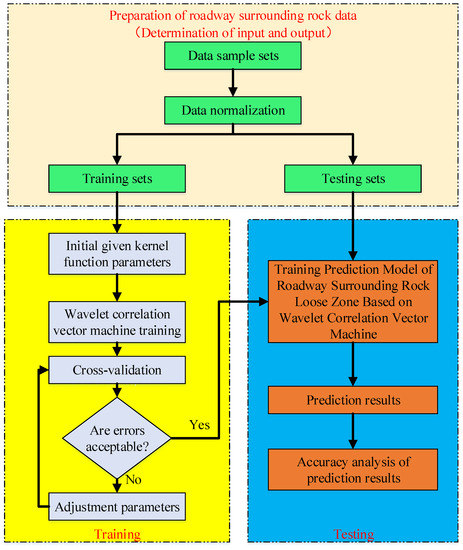
Figure 3.
Prediction model of surrounding rock loose circle in roadway.
(1) Determining input and output. Predicting the roadway surrounding rock loose zone, the main factors having an impact on the thickness of roadway surrounding rock loose zone are selected as the evaluation index, that is, the input of the prediction model (i = 1,2... D). The thickness of loose zone is the output of the prediction model Y.
(2) Preprocessing sample data. In order to eliminate the influence of inconsistent evaluation index dimension on data analysis, it needs to standardize the samples, that is, to divide the statistical data by the standard deviation of the data after zero-mean. It is to ensure that the mean value of each statistical data after processing is 0 and the variance is 1.
(3) Establishing the thickness prediction model of loose zone. The use of the cross-validation method [63] for the optimization of the kernel function parameters. The commonly used cross-validation methods include leave-out method, K-fold cross-validation and leave-one validation. Leave-out method was applied in this study to randomly separate the training samples into two parts. The first part is applied as training set to train the model. Another is used as validation set to validate the parameters and model. Therefore, the core parameters which render the smallest verification set RMS error can be selected. Using all training samples, the predictive model of roadway surrounding rock loose zone using WRVM has been established.
(4) Predicting loose zone thickness based on the model. Equation (6) can be used to predict the thickness of the loose zone after establishing the prediction model of the main factors and the loose zone thickness of roadway surrounding rock. Among them, is the model predictive value, the variance information of the current predictive value.
(5) Analyzing model accuracy. After establishing the prediction model of surrounding rock loose zone, the accuracy of the model is evaluated by Equations (11)–(13).
4. Application Analysis
4.1. Selection of Main Influencing Factors
There are many factors making a difference to the thickness of loose zone. The complex relationship between them often shows strong nonlinearity. Currently, there is no universal mathematical model. Based on the relevant literature [64,65] and the principles of simplicity, independence and accessibility, the influence of in situ stress on the size of loose zone is reflected by roadway burial depth, and the influence of roadway span and roadway section area on the size of loose zone is reflected by the geometric size and shape of roadway. Five indexes are used to predict the thickness of loose zone.
(1) Depth of roadway. The thickness of roadway surrounding rock loose zone increases with the roadway burial depth.
(2) Span of roadway. The thickness of roadway surrounding rock loose zone increases with the roadway span.
(3) Strength of surrounding rock. The difficulty of resisting failure of surrounding rock can be reflected by the surrounding rock strength, and the thickness of loose zone is inversely proportional to the surrounding rock strength. The strength of surrounding rock can be described by selected rock uniaxial compressive strength Rc.
(4) Development degree of surrounding rock joints. Joints are small fracture structures with no significant displacement on both sides of rock mass after stress fracture. The greater the degree of joint development, the greater the thickness of loosening zone.
(5) Sectional area of roadway. The size of roadway section also makes a difference to the thickness of loose zone which is proportional to the roadway section area.
4.2. Sample Selection
The surrounding rock loose zones of some mines in China have been counted [66,67]. The statistical data is shown in Table 1. Five indexes affecting the thickness of surrounding rock loose zone are taken as input vectors, and the thickness of surrounding rock loose zone is taken as output vectors. A prediction model of surrounding rock loosening zone based on WRVM has been established. Sample sets 1–40 of data were selected as training data, and sample sets 41–55 were used as prediction data.

Table 1.
Statistics of surrounding rock loose zones in mines.
4.3. Kernel Function Parameter Determination
Cross-validation is a commonly used method to select the optimal parameters. By using cross-validation method, 28 groups of training set were randomly selected in the first 40 groups, and the remaining 12 groups were used as the validation set. The model was established by setting different parameters of the kernel function to validate the kernel function parameters. Through six cross validations, the RMS error of validation set under different kernel parameters is shown in Figure 4. According to the results of six cross validations, the optimal value of the model core parameters is chosen when the root mean square error is the smallest. According to the calculation results, the kernel parameters of Gauss-RVM are 12.5, and those of the Mexican relevance vector machine, the Morlet relevance vector machine, the and DOG relevance vector machine are 20, 22.5 and 12.5, respectively.
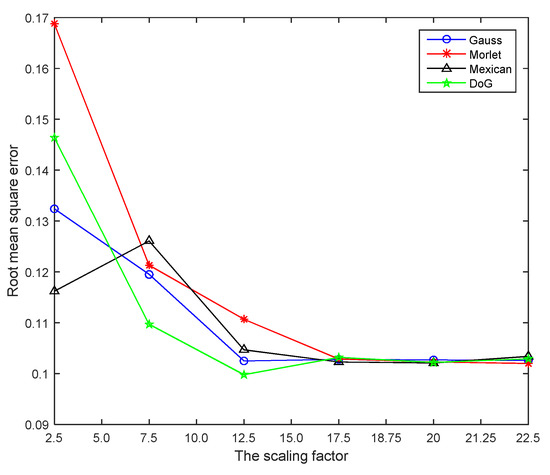
Figure 4.
Root mean square (RMS) errors of verification sets under different kernel parameter values.
The experimental results of root mean square (RMS) errors of support vector machine (SVM), relevance vector machine (Gauss-RVM), wavelet relevance vector machine (Mexican relevance vector machine, Morlet relevance vector machine and DOG relevance vector machine) are compared, as illustrated in Table 2.

Table 2.
Comparison of RMS errors.
By analyzing Table 2, all three WRVMs have good modeling robustness, and the modeling accuracy is better than the other two methods.
4.4. Result Analysis
Between the 41 to 55 groups of samples selected as test data, the predictive results of the loose zone can be calculated by inputting the data into the prediction model of the surrounding rock loose zone using WRVM. The average relative prediction errors of support vector machine (SVM), relevance vector machine (Gauss-RVM), wavelet relevance vector machine (Mexican relevance vector machine, Morlet relevance vector machine and DOG relevance vector machine) models are illustrated in Table 3.

Table 3.
Average relative prediction errors of each model.
Table 3 shows that the average relative prediction errors of the Mexican relevance vector machine, the Morlet relevance vector machine, and the DOG relevance vector machine models are accordingly 4.581%, 4.586% and 4.575%. WRVM has higher accuracy than SVM and RVM. It shows that the model has achieved some accuracy and reliability in practical engineering applications. Taking the Mexican-RVM forecasting model as an example, the results of training sample modeling were analyzed as illustrated in Figure 5, the model forecasting results in Figure 6, model forecasting results in Figure 7, and model forecasting error results in Figure 8.
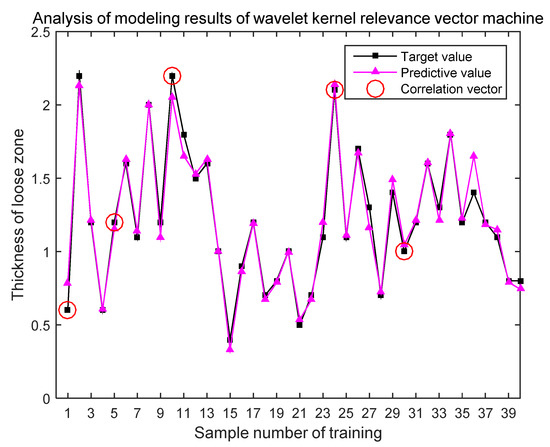
Figure 5.
Analysis of modeling results of wavelet relevance vector machine (WRVM).

Figure 6.
Prediction results of WRVM model.
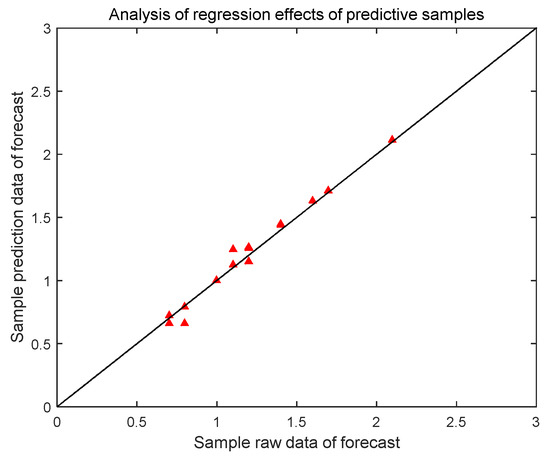
Figure 7.
Analysis of the fitting effect.

Figure 8.
Prediction error of prediction samples.
Figure 5 shows that the prediction model of WRVM trained with 40 sets of data has a good fitting effect. There are five relevance vectors. The number of relevance vectors is reasonable. They reflect the core characteristics of the data.
Figure 6 shows the predicted sample’s target value and predictive value and prediction upper and lower bound and also gives the interval information of the predicted value based on probability, which increases the reliability of the predicted results and provides more decision support for the prediction of the surrounding rock loosening zone in engineering practice.
The paper further analyzed the fitting effect between the predicted results and the real values. The complex relevance coefficient R of the predicted samples is 0.97613, and the fitting effect is shown in Figure 7. The square correlation coefficient is 0.95 > 0.9, which further demonstrates that the fitting results of the prediction results are better. From Figure 8, it can be seen that only two roadways have a prediction error of more than 10%. In general, the predicted result has high reliability.
The results of SVM prediction model are shown in Figure 9, the results of relevance vector machine prediction model are shown in Figure 10, and the calculation efficiency of each prediction model is shown in Table 4. Through further comparative analysis, it is found that the accuracy and reliability of the wavelet correlation vector machine prediction model are better.
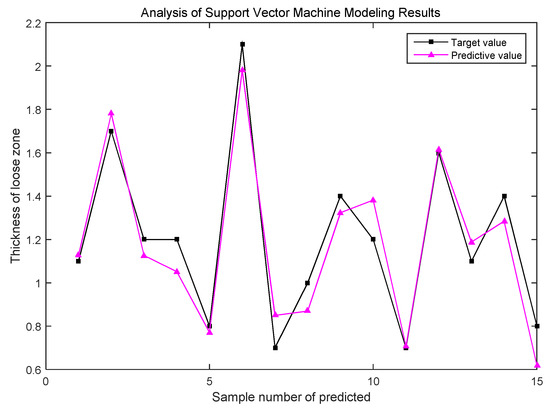
Figure 9.
Prediction results of SVM model.
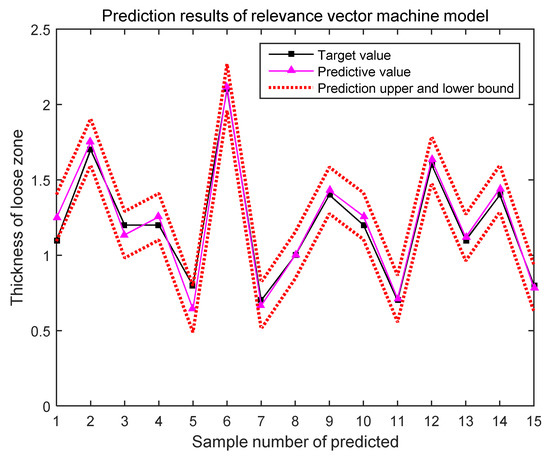
Figure 10.
Prediction results of RVM model.

Table 4.
Computational efficiency of each model.
5. Conclusions
Based on the theory of RVM, the wavelet function was introduced to replace the original Gauss function as the model kernel function. Five factors affecting the loose zone of roadway surrounding rock have been selected as the model input. The predictive model of the loose zone of roadway surrounding rock using WRVM was established. Mean square error, relative prediction error and square correlation coefficient were introduced to estimate the model accuracy. The major findings for the paper are listed below.
(1) By applying cross-validation, the kernel parameters of were respectively calculated to be 20, 22.5 and 12.5. By comparing the RMS error of the experimental results of SVM, Gauss-RVM and WRVM, the advantages and accuracy of the proposed WRVM model are verified.
(2) In practical engineering applications, the average relative prediction errors of three WRVMs models are accordingly 4.581%, 4.586% and 4.575%. The probability intervals of prediction values were given. The square correlation coefficient of prediction samples is 0.95 > 0.9, which further verifies the accuracy and reliability of the predictive model of roadway surrounding rock loose zone using the proposed WRVM.
Author Contributions
Y.L. contributed to the analytical method and program codes, taking charge of data analysis and paper writing while Q.W. and Y.Y. were responsible for the research supervision and paper revising. X.L. and W.W. took charge of the data analysis. The last script has been perused and approved by all writers.
Funding
The research got the support of the National Natural Science Foundation of China (No. 51574183) and Open Fund of Hubei Key Laboratory of Mechanical Transmission and Manufacturing Engineering of China (No. 2018A09).
Conflicts of Interest
The authors declare no conflicts of interest.
References
- Wang, R.; Deng, X.H.; Meng, Y.Y.; Yuan, D.Y.; Xia, D.H. Case Study of Modified H–B Strength Criterion in Discrimination of Surrounding Rock Loose Circle. KSCE J. Civ. Eng. 2019, 23, 1395–1406. [Google Scholar] [CrossRef]
- Li, F.; Quan, X.; Jia, Y.; Wang, B.; Zhang, G.; Chen, S. The experimental study of the temperature effect on the interfacial properties of fully grouted rock bolt. Appl. Sci. 2017, 7, 327. [Google Scholar] [CrossRef]
- Luo, M.; Li, W.; Wang, B.; Fu, Q.; Song, G. Measurement of the length of installed rock bolt based on stress wave reflection by using a giant magneto strictive (GMS) actuator and a PZT sensor. Sensors 2017, 17, 444. [Google Scholar] [CrossRef] [PubMed]
- Ho, S.C.M.; Li, W.; Wang, B.; Song, G. A load measuring anchor plate for rock bolt using fiber optic sensor. Smart Mater. Struct. 2017, 26, 057003. [Google Scholar] [CrossRef]
- Wang, B.; Huo, L.; Chen, D.; Li, W.; Song, G. Impedance-based pre-stress monitoring of rock bolts using a piezoceramic-based smart washer—A feasibility study. Sensors 2017, 17, 250. [Google Scholar] [CrossRef]
- Lu, A.; Xu, J.; Liu, H. Effect of a preload force on anchor system frequency. Int. J. Min. Sci. Technol. 2013, 23, 135–138. [Google Scholar] [CrossRef]
- Huo, L.; Wang, B.; Chen, D.; Song, G. Monitoring of pre-load on rock bolt using piezoceramic-transducer enabled time reversal method. Sensors 2017, 17, 2467. [Google Scholar] [CrossRef]
- Kong, Q.; Zhu, J.; Ho, S.C.M.; Song, G. Tapping and listening: A new approach to bolt looseness monitoring. Smart Mater. Struct. 2018, 27, 07LT02. [Google Scholar] [CrossRef]
- Jiang, S.H.; Li, D.Q.; Zhang, L.M.; Zhou, C.B. Time-dependent system reliability of anchored rock slopes considering rock bolt corrosion effect. Eng. Geol. 2014, 175, 1–8. [Google Scholar] [CrossRef]
- Peng, J.; Hu, S.; Zhang, J.; Cai, C.S.; Li, L.Y. Influence of cracks on chloride diffusivity in concrete: A five-phase mesoscale model approach. Constr. Build. Mater. 2019, 197, 587–596. [Google Scholar] [CrossRef]
- Vandermaat, D.; Saydam, S.; Hagan, P.C.; Crosky, A.G. Examination of rock bolt stress corrosion cracking utilizing full size rock bolts in a controlled mine environment. Int. J. Rock Mech. Min. Sci. 2016, 81, 86–95. [Google Scholar] [CrossRef]
- Craig, P.; Serkan, S.; Hagan, P.; Hebblewhite, B.; Vandermaat, D.; Crosky, A.; Elias, E. Investigations into the corrosive environments contributing to premature failure of Australian coal mine rock bolts. Int. J. Min. Sci. Technol. 2016, 26, 59–64. [Google Scholar] [CrossRef]
- Guo, X.F.; Zhao, Z.Q.; Gao, X.; Wu, X.Y.; Ma, N.J. Analytical solutions for characteristic radii of circular roadway surrounding rock plastic zone and their application. Int. J. Min. Sci. Technol. 2018, 29, 263–272. [Google Scholar] [CrossRef]
- Hao, Z.Y.; Lin, B.Q.; Gao, Y.B.; Cheng, Y.Y. Establishment and application of drilling sealing model in the spherical grouting mode based on the loosing-circle theory. Int. J. Min. Sci. Technol. 2012, 22, 895–898. [Google Scholar] [CrossRef]
- Liu, Y.; Ye, Y.C.; Wang, Q.H.; Liu, X.Y. Stability Prediction Model of Roadway Surrounding Rock Based on Concept Lattice Reduction and a Symmetric Alpha Stable Distribution Probability Neural Network. Appl. Sci. 2018, 8, 2164. [Google Scholar] [CrossRef]
- Song, G.; Li, W.; Wang, B.; Ho, S.C.M. A review of rock bolt monitoring using smart sensors. Sensors 2017, 17, 776. [Google Scholar] [CrossRef]
- Song, G.; Wang, C.; Wang, B. Structural health monitoring (SHM) of civil structures. Appl. Sci. 2017, 7, 789. [Google Scholar] [CrossRef]
- Kong, Q.; Robert, R.H.; Silva, P.; Mo, Y.L. Cyclic crack monitoring of a reinforced concrete column under simulated pseudo-dynamic loading using piezoceramic-based smart aggregates. Appl. Sci. 2016, 6, 341. [Google Scholar] [CrossRef]
- Yi, C.; Lv, Y.; Xiao, H.; Huang, T.; You, G. Multisensory signal denoising based on matching synchro squeezing wavelet transform for mechanical fault condition assessment. Meas. Sci. Technol. 2018, 29, 045104. [Google Scholar] [CrossRef]
- Huang, Y.; Kou, J.S.; Fang, H.B.; Li, M.L.; Liang, Y. Research on Determination Loose Zone of Surrounding Rock in Highway Tunnel. Appl. Mech. Mater. 2015, 724, 185–191. [Google Scholar] [CrossRef]
- Cui, F.Z.; Xue, H.J.; He, T.Y.; Li, T.T.; Zuo, J.J.; Guan, X. Research on Loose Circle Test of Deep Broken Roadway. Appl. Mech. Mater. 2014, 638, 904–907. [Google Scholar] [CrossRef]
- Wang, F.; Liu, Z.; An, C. Sonic wave testing technique for surrounding rock loose circle. In Proceedings of the International Conference on Multimedia Technology, Hangzhou, China, 26–28 July 2011. [Google Scholar]
- Xia, H.B.; Xu, Y.; Zhang, Y.J. Numerical Simulation and Experimental Analysis of Roadway Surrounding; Rock Loose Circle under Blasting Vibration. In Proceedings of the Fourth International Conference on Digital Manufacturing & Automation, Qingdao, China, 29–30 June 2013. [Google Scholar]
- Ming, X.; Yongxing, Z.; Ke, Y. Prediction of limit bearing capacity of bolt using artificial neural networks. Chinese. J. Rock Mech. Eng. 2002, 21, 755–758. [Google Scholar]
- Wang, H.; Song, G. Innovative NARX recurrent neural network model for ultra-thin shape memory alloy wire. Neurocomputing 2014, 134, 289–295. [Google Scholar] [CrossRef]
- Mai, H.; Song, G.; Liao, X. Adaptive online inverse control of a shape memory alloy wire actuator using a dynamic neural network. Smart Mater. Struct. 2012, 22, 015001. [Google Scholar] [CrossRef]
- Wang, B.; Mo, C.; He, C.; Yan, Q. Fuzzy synthetic evaluation of the long-term health of tunnel structures. Appl. Sci. 2017, 7, 203. [Google Scholar] [CrossRef]
- Li, L.; Song, G.; Ou, J. Adaptive fuzzy sliding mode based active vibration control of a smart beam with mass uncertainty. Struct. Control Health Monitor. 2011, 18, 40–52. [Google Scholar] [CrossRef]
- Gu, H.; Song, G.; Malki, H. Chattering-free fuzzy adaptive robust sliding-mode vibration control of a smart flexible beam. Smart Mater. Struct. 2008, 17, 035007. [Google Scholar] [CrossRef]
- Vardakos, S.; Gutierrez, M.; Xia, C. Parameter identification in numerical modeling of tunneling using the Differential Evolution Genetic Algorithm (DEGA). Tunn. Undergr. Space Technol. 2012, 28, 109–123. [Google Scholar] [CrossRef]
- Luyu, L.; Song, G.; Jinping, O. A Genetic Algorithm-based Two-phase Design for Optimal Placement of Semi-active Dampers for Nonlinear Benchmark Structure. J. Vib. Control 2010, 16, 1379–1392. [Google Scholar]
- Yang, W.; Kong, Q.; Ho, S.C.M.; Mo, Y.L.; Song, G. Real-Time Monitoring of Soil Compaction Using Piezoceramic-Based Embeddable Transducers and Wavelet Packet Analysis. IEEE Access 2018, 6, 5208–5214. [Google Scholar] [CrossRef]
- Jiang, T.; Kong, Q.; Patil, D.; Luo, Z.; Huo, L.; Song, G. Detection of debonding between fiber reinforced polymer bar and concrete structure using piezoceramic transducers and wavelet packet analysis. IEEE Sens. J. 2017, 17, 1992–1998. [Google Scholar] [CrossRef]
- Lee, I.M.; Han, S.I.; Kim, H.J.; Yu, J.D.; Min, B.K.; Lee, J.S. Evaluation of rock bolt integrity using Fourier and wavelet transforms. Tunn. Undergr. Space Technol. 2012, 28, 304–314. [Google Scholar] [CrossRef]
- Zhao, H.; Li, S.; Ru, Z. Adaptive reliability analysis based on a support vector machine and its application to rock engineering. Appl. Math. Model. 2017, 44, 508–522. [Google Scholar] [CrossRef]
- Zhao, X.; Li, W.; Zhou, L.; Song, G.; Ba, Q.; Ho, S.C.M.; Ou, J. Application of support vector machine for pattern classification of active thermometry-based pipeline scour monitoring. Struct. Control Health Monit. 2015, 22, 903–918. [Google Scholar] [CrossRef]
- Li, S.; Zhao, H.; Ru, Z.; Sun, Q. Probabilistic back analysis based on Bayesian and multi-output support vector machine for a high cut rock slope. Eng. Geol. 2016, 203, 178–190. [Google Scholar] [CrossRef]
- Singh, T.N.; Verma, A.K. Comparative analysis of intelligent algorithms to correlate strength and petrographic properties of some schistose rocks. Eng. Comput. 2012, 28, 1–12. [Google Scholar] [CrossRef]
- Liu, C.; Zhou, D.; Wang, Z.; Yang, D.; Song, G. Damage Detection of Refractory Based on Principle Component Analysis and Gaussian Mixture Model. Complexity 2018. [Google Scholar] [CrossRef]
- Yi, T.H.; Li, H.N.; Song, G.; Zhang, X.D. Optimal sensor placement for health monitoring of high-rise structure using adaptive monkey algorithm. Struct. Control Health Monit. 2015, 22, 667–681. [Google Scholar] [CrossRef]
- Zhou, J.; Li, X.B. Evaluating the Thickness of Broken Rock Zone for Deep Roadways using Nonlinear SVMs and Multiple Linear Regression Model. Procedia Eng. 2011, 26, 972–981. [Google Scholar] [CrossRef][Green Version]
- Mehrotra, H.; Singh, R.; Vatsa, M.; Majhi, B. Incremental granular relevance vector machine: A case study in multimodal biometrics. Pattern Recognit. 2016, 56, 63–76. [Google Scholar] [CrossRef]
- He, S.M.; Xiao, L.; Wang, Y.L.; Liu, X.G.; Yang, C.H.; Lu, J.G.; Gui, W.H.; Sun, Y.X. A novel fault diagnosis method based on optimal relevance vector machine. Neurocomputing 2017, 267, 651–663. [Google Scholar] [CrossRef]
- Wang, Y.; Wang, P.F.; Ding, K. Pattern recognition using relevant vector machine in optical fiber vibration sensing system. Appl. Soft Comput. 2019, 7, 5886–5895. [Google Scholar] [CrossRef]
- Habeeb, A.; Jale, T. Relevance vector machines modeling of nonstationary ground motion coherency. Soil Dyn. Earthq. Eng. 2019, 120, 262–272. [Google Scholar]
- Samagassi, S.; Khamlichi, A.; Driouach, A.; Jacquelin, E. Reconstruction of multiple impact forces by wavelet relevance vector machine approach. J. Sound Vib. 2015, 359, 56–67. [Google Scholar] [CrossRef]
- Tipping, M.E. The relevance Vector Machine. Adv. Neural Inf. Process. Syst. 2000, 12, 652–658. [Google Scholar]
- Tipping, M.E. Sparse Bayesian learning and the relevance vector machine. J. Mach. Learn. Res. 2001, 3, 211–244. [Google Scholar]
- He, F.; Xu, J.W.; Li, M.; Yang, J.H. Product quality modelling and prediction based on wavelet relevance vector machines. Chemom. Intell. Lab. Syst. 2013, 121, 33–41. [Google Scholar]
- Wang, F.; Gou, B.; Qin, Y. Modeling tunneling-induced ground surface settlement development using a wavelet smooth relevance vector machine. Comput. Geotech. 2013, 54, 125–132. [Google Scholar] [CrossRef]
- Schölkopf, B. Learning with Kernels: Support Vector Machines, Regularization, Optimization, and Beyond; The MIT Press: London, UK, 2001. [Google Scholar]
- Li, D.; Liang, Y.; Feng, Q.; Song, G. Load monitoring of the pin-connected structure based on wavelet packet analysis using piezoceramic transducers. Measurement 2018, 122, 638–647. [Google Scholar] [CrossRef]
- Xu, B.; Li, B.; Song, G. Active Debonding Detection for Large Rectangular CFSTs Based on Wavelet Packet Energy Spectrum with Piezoceramics. ASCE J. Struct. Eng. 2013, 139, 1435–1443. [Google Scholar] [CrossRef]
- Zhang, L.; Zhou, W.D.; Jiao, L.C. Wavelet support vector machine. IEEE Trans. Syst. Man Cybern Part B 2004, 34, 34. [Google Scholar] [CrossRef]
- Xu, Y.; Luo, M.; Li, T.; Song, G. ECG Signal De-noising and Baseline Wander Correction Based on CEEMDAN and Wavelet Threshold. Sensors 2017, 17, 2754. [Google Scholar] [CrossRef] [PubMed]
- Chen, G.C.G.; Dudek, G. Auto-correlation wavelet support vector machine and its applications to regression. In Proceedings of the 2nd Canadian Conference on Computer and Robot Vision, Victoria, BC, Canada, 9–11 May 2005. [Google Scholar]
- Dimitris, T.; Aristidis, L.; Nikolaos, G. Incremental relevance vector machine with kernel learning. In Lecture Notes in Computer Science; Springer: Berlin/Heidelberg, Germany, 2008; pp. 301–312. [Google Scholar]
- Yuan, J.; Bo, L.F.; Wang, K. Adaptive spherical Gaussian kernel in sparse Bayesian learning framework for nonlinear regression. Expert Syst. Appl. 2009, 36, 3982–3989. [Google Scholar] [CrossRef]
- Candela, J.Q. Learning with Uncertainty Gaussian Processes and Relevance Vector Machines. Ph.D. Thesis, Technical University of Denmark, Lyngby, Denmark, 2004. [Google Scholar]
- Yuan, J.; Wang, K.S.; Yu, T.; Fang, M.L. Integrating relevance vector machines and genetic algorithms for optimization of seed-separating process. Eng. Appl. Artif. Intell. 2007, 20, 970–979. [Google Scholar] [CrossRef]
- Nikolaev, N.; Tino, P. Sequential relevance vector machine learning from time series. In Proceedings of the International Joint Conference on Neural Networks, Montreal, QC, Canada, 31 July–4 August 2005; pp. 1303–1313. [Google Scholar]
- Kim, K.; Lee, J.M.; Lee, I.B. A novel multivariate regression approach based on kernel partial least squares with orthogonal signal correction. Chemom. Intell. Lab. Syst. 2005, 79, 22–30. [Google Scholar] [CrossRef]
- Xu, L.; Fu, H.Y.; Goodarzi, M.; Cai, C.B.; Yin, Q.B.; Wu, Y.; Tang, B.C.; She, Y.B. Stochastic cross validation. Chemom. Intell. Lab. Syst. 2018, 175, 74–81. [Google Scholar] [CrossRef]
- Zhang, P.; Wang, Y.; Qin, G. Fuzzy Damage Analysis of the Seismic Response of a Long-Distance Pipeline under a Coupling Multi-Influence Domain. Energies 2019, 12, 62. [Google Scholar] [CrossRef]
- Qiu, D.H.; Li, S.C.; Zhang, L.W.; Xue, Y.G. Application of GA-SVM in classification of surrounding rock based on model reliability examination. Min. Sci. Technol. 2010, 20, 428–433. [Google Scholar] [CrossRef]
- Shi, S.S.; Li, S.C.; Li, L.P.; Zhou, Z.Q.; Wang, J. Advance optimized classification and application of surrounding rock based on fuzzy analytic hierarchy process and Tunnel Seismic Prediction. Autom. Constr. 2014, 37, 217–222. [Google Scholar] [CrossRef]
- Zhu, Z.J.; Zhang, H.W.; Chen, Y. Prediction model of loosening zones around roadway based on MPSOSVM. Comput. Eng. Appl. 2014, 50, 1–5. [Google Scholar]
© 2019 by the authors. Licensee MDPI, Basel, Switzerland. This article is an open access article distributed under the terms and conditions of the Creative Commons Attribution (CC BY) license (http://creativecommons.org/licenses/by/4.0/).